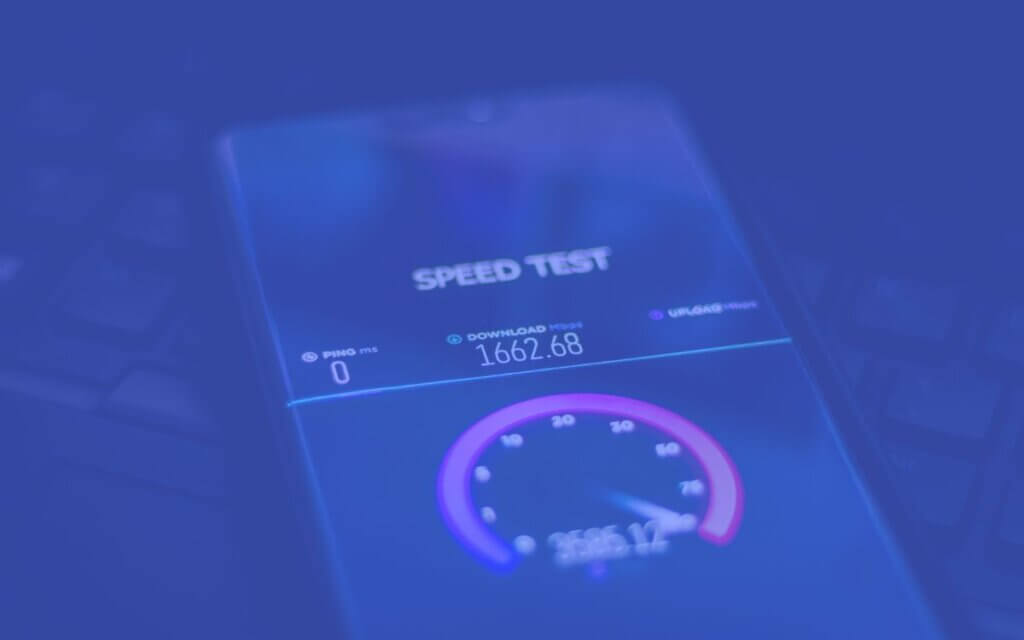Lower your internet bill
61% of people overpay for their internet.
Are you one of them?
Unlock exclusive offers in your area!
Call now
[tel]Enter zip code
1 Star is Poor & 5 Stars is Excellent.
* Required

Written by Rosslyn Elliott - Pub. Jul 10, 2024 / Updated Sep 30, 2024
Table of Contents
Are you happy with your Internet service?

About the author
How fast is “high-speed internet” in 2024 — and do you really need it?
That depends on what you do every day online, and who else will be using your home internet connection.
Whether you live a fast-paced city life or prefer the peace of rural areas, you need information that is customized for your location and your internet activity.
By the end of this overview, you’ll know what “high-speed” means officially, and what it means for you. You’ll be ready to choose the internet speed that works best for your digital lifestyle.
High-speed internet, often called broadband, is any type of internet connection that transmits data much more quickly than dial-up or most DSL services.
Broadband internet is always connected, so you don’t have to dial in every time you want to go online.
Unlike dial-up, which uses a single channel, broadband uses multiple channels, allowing for much faster data transmission. DSL internet was the first form of broadband when it came out in the 1990s [1]. But technology has advanced to the point that most DSL is now too slow to be called “high-speed.”
Advantages of broadband over dial-up or slow DSL:
But where is the line to decide which connections qualify as “high-speed"? The Federal Communications Commission (FCC) recently raised its standard.
From 2015 until this year, the FCC’s definition of broadband had been 25 Mbps download/3 Mbps upload speed [2].
But as of 2024, the FCC defines broadband as internet service with download speeds of at least 100 Mbps and upload speeds of at least 20 Mbps [3].
That’s why you’re going to start seeing a lot more references from internet service providers to 100 downstream/20 upstream.

Do you need broadband?
Digital Subscriber Line (DSL)
In 2024, DSL internet rarely qualifies as “high-speed.” DSL uses existing phone lines to transmit data. It’s widely available but slower than most other internet options.
DSL download speeds can range from 5 Mbps to 100 Mbps, depending on your distance from the provider’s central office. DSL upload speeds vary from 1-20 Mbps.
DSL sometimes qualified as high-speed internet when the FCC set the benchmark at 25 download/3 upload. Under the new standard, DSL is mostly not fast enough to be called broadband.
Only a small percentage of households have DSL at the upper end of the speed range. Average DSL speed is more likely to be 10-25 Mbps download, and average DSL upload speeds do not usually rise above 5 Mbps [4].
Cable
Cable internet uses the same coaxial cables that deliver cable TV, often along with sections of fiber-optic line to create hybrid fiber-coaxial (HFC). It’s fast and widely available in urban and suburban areas. Cable plan download speeds range from 50 Mbps to 1 Gbps (1 Gig) or more.
All large cable providers now provide options that qualify as high-speed internet. Though cable’s upload speeds are far slower than fiber’s, you’ll have enough speed to support your internet activities. And DOCSIS 4.0 may usher in higher upload speeds for cable in the next few years.
Fiber
Fiber-optic internet uses thin glass or plastic fibers to transmit data via light signals. It’s the fastest option available but not yet widely accessible. Fiber can deliver speeds up to 10 Gbps or even 50 Gbps. Fiber is the fastest internet technology by far.
Fiber internet is the only internet technology that has equal upload and download speeds. So, if your download speed is 200 Mbps, your upload speed is the same. No other technology comes close right now for upload speeds.
Satellite
Satellite internet beams data from orbiting satellites to a dish at your home. Satellite is available almost anywhere but can be affected by weather and tends to have higher latency. Speeds can range from 12 Mbps to 250 Mbps download, and 5 Mbps to 20 Mbps upload. Low-earth orbit satellites (LEO) currently have the highest speeds and lowest latency.
Fixed Wireless
Fixed wireless internet uses radio waves to transmit data from a ground station to an antenna at your home. It’s a good option for rural areas where wired connections aren’t available. Speeds can range from 10 Mbps to 1 Gbps.

First, it’s a good idea to know your current internet speed. Your actual speed may differ from your provider’s maximum advertised speed [5].
Our internet speed test will show you three key metrics:
Run a speed test during peak usage hours to get an accurate picture of your typical speeds. And plug your device in with an Ethernet cable to make sure your home Wi-Fi isn’t slowing you down.
A “good" internet speed depends on your activities, but here are some general guidelines:
Remember, these are download speeds. Unless you have fiber internet, upload speeds are typically lower.
While download speeds have traditionally been the focus, upload speeds are becoming increasingly crucial. Here’s why:
Internet speed is measured in megabits per second (Mbps) or in gigabits per second (Gbps). Your ideal level of speed will depend on three main factors:

How many devices in your home?
Here’s a more detailed breakdown:
For Individuals:
For Households:
For Specific Activities:
Remember to add more speed for multiple simultaneous users and build in extra bandwidth for peak usage times and future needs.
The cost of high-speed internet varies widely depending on your location, the type of connection, and the speed tier you choose. Generally, you can expect to pay:
Many providers offer introductory rates that increase after the first year, so be sure to read the fine print. Some providers also offer bundle deals with TV or phone service, which can provide savings.
Some of the top high-speed internet providers in the U.S. include:
AT&T (Fiber and DSL)
Bluepeak (Fiber and Cable)
Brightspeed (Fiber and DSL)
CenturyLink (DSL)
Cox (Cable)
Earthlink (Fiber, Fixed Wireless, Satellite)
Fidium Fiber (Fiber)
Frontier (Fiber and DSL)
Hughesnet (Satellite)
Kinetic by Windstream (Fiber and DSL)
Lumos (Fiber)
Metronet (Fiber)
Optimum (Cable)
Quantum Fiber (Fiber)
Spectrum (Cable)
T-Mobile (Fixed wireless)
Verizon Fios (Fiber)
Viasat (Satellite)
WOW! (Fiber and Cable)
Xfinity (Cable)
Ziply Fiber (Fiber and DSL)
Availability of service from these providers varies by region. Some areas may have additional local or regional providers. Enter your zip code to find out which providers serve you.

Rural areas have fewer providers
Rural areas often face challenges in accessing high-speed internet. If you live in a rural area, consider these options:
Challenges in rural broadband deployment include:
However, there are ongoing efforts to bridge the rural-urban digital divide. Check with local providers and your local government for initiatives to expand rural broadband access.
High-speed internet has become essential in various aspects of modern life:
Several factors can impact your actual internet speed:
See our article for more information on how to get your best internet quality.

Optimize your Wi-Fi setup
Recognizing the importance of broadband access, various government initiatives aim to expand high-speed internet availability:
These programs aim to close the digital divide and ensure that all Americans have access to high-speed internet.
The world of high-speed internet is constantly evolving. Here are some trends to watch:

High-speed internet of the future
Mbps stands for megabits per second, while MB means megabytes. Mbps refers to internet speed, while MB refers to data use or storage. See our article on megabits vs megabytes for more.
If you’re upgrading your speed significantly, you may need a new modem to take full advantage of the faster speeds. See our guide to whether to buy a modem or use one from your provider depending on whether your provider charges equipment fees.
Yes, weather can make a difference for satellite and fixed wireless connections. Heavy rain or snow can interfere with the signal.
5G home internet can provide high-speed, broadband-like service, but it’s not widely available yet. It could be a game-changer for rural areas in the future.
Place your router in a central location, away from walls and metal objects. Consider a Wi-Fi extender for large homes. And make sure your router is up-to-date — older models may not support the fastest speeds.
[1] IEEE.org. “Inventor of DSL Altered Connectivity."
[2] FCC.gov. “2015 Broadband Progress Report."
[3] FCC.gov. “FCC Increases Broadband Speed Benchmark."
[4] Speedguide.net. “What is the fastest speed for DSL connections?"
[5] Purdue.edu. “Advertised vs. actual internet speeds."
[6] Brookings.edu. “The Economy and the Internet."
[7] Telehealth.HHS.gov. “Access to Internet and Other Telehealth Resources."
[8] WhiteHouse.gov. “Bipartisan Infrastructure Deal."
[9] USAC.org. “Rural Digital Opportunity Fund."
[10] FCC.gov. “E-Rate Program."
[11] LifelineSupport.org.

About the author
Congratulations, you qualify for deals on internet plans.
Speak with our specialists to access all local discounts and limited time offers in your area.
[tel]61% of people overpay for their internet.
Are you one of them?
Unlock exclusive offers in your area!
Call now
[tel]Enter zip code